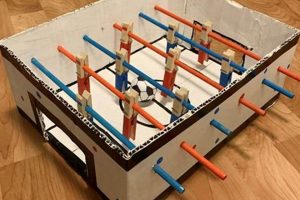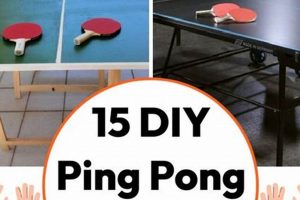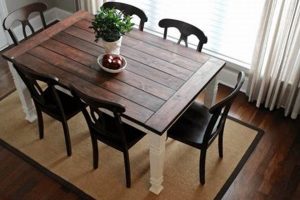Surface coverings for tables, individually manufactured and typically square or rectangular, offer an avenue for personalization and aesthetic enhancement. These elements are often ceramic, stone, glass, or composite materials affixed to a table surface using adhesive. A mosaic, for example, demonstrates one application, where small pieces create intricate designs on a tabletop.
Employing such surface coverings offers several advantages. They provide durability and resistance to heat, scratches, and moisture. They can transform a utilitarian object into a visually striking focal point within a room. Historically, this method of table adornment has provided a medium for artistic expression and a means of protecting vulnerable table surfaces from wear and tear.
The subsequent discussion will elaborate on the selection process, installation techniques, design considerations, and maintenance procedures associated with this popular home improvement activity.
Tips for Tabletop Surface Covering Projects
Successful execution of tabletop surface covering projects requires careful planning and meticulous application. Adherence to established best practices will contribute to a durable and aesthetically pleasing result.
Tip 1: Material Selection is Paramount. Prioritize materials suitable for the intended use of the table. For dining tables, consider stain-resistant and easily cleanable options. For outdoor applications, select frost-resistant and UV-resistant materials.
Tip 2: Surface Preparation is Critical. Ensure the existing tabletop surface is clean, level, and free from debris. Sanding or applying a bonding primer may be necessary to promote proper adhesion.
Tip 3: Accurate Measurement and Layout are Essential. Precisely measure the tabletop dimensions and create a detailed layout plan. This minimizes waste and ensures a symmetrical and visually appealing design.
Tip 4: Employ Appropriate Adhesives. Use adhesives specifically formulated for the chosen surface covering material and the table substrate. Carefully follow the manufacturer’s instructions regarding application techniques and curing times.
Tip 5: Grout Selection and Application Impact Aesthetics and Durability. Choose a grout color that complements the surface covering material. Ensure the grout is properly mixed and applied, completely filling the spaces between individual pieces. Consider sealing the grout to enhance stain resistance.
Tip 6: Utilize Cutting Tools Appropriately. Employ a wet saw or manual cutter designed for the specific surface covering material. This ensures clean, precise cuts, minimizing chipping and breakage.
Tip 7: Dry Fit Before Adhering Permanently. Arrange the tabletop surface covering materials without adhesive to ensure a proper fit and the desired aesthetic. Make any necessary adjustments before permanently adhering them to the tabletop surface.
Careful attention to detail throughout the process, from material selection to grout application, will yield a functional and attractive tabletop that enhances the surrounding environment.
The following sections will address specific design considerations and ongoing maintenance procedures.
1. Material Durability
Material durability is a paramount consideration in tabletop surface covering projects, directly influencing the longevity, functionality, and aesthetic appeal of the finished product. The selection of materials resistant to common stressors associated with table use is crucial for sustained performance.
- Resistance to Abrasion
The material’s ability to withstand scratching and wear from everyday use is a key factor. Ceramic and porcelain, for example, exhibit high abrasion resistance, making them suitable for high-traffic tables. Conversely, softer materials may require protective coatings or be relegated to decorative applications.
- Moisture Impermeability
The capacity to resist water absorption is essential to prevent staining, warping, and the growth of mold or mildew. Materials like glazed ceramic, epoxy grout, and certain types of stone possess inherent impermeability. Appropriate sealing can enhance the moisture resistance of more porous materials.
- Thermal Stability
Tables, particularly those used in kitchens or outdoors, are frequently exposed to varying temperatures. Materials should demonstrate stability under thermal stress to prevent cracking or deformation. Natural stone and certain engineered composites are well-suited for environments with fluctuating temperatures.
- Impact Resistance
The likelihood of accidental impacts necessitates selecting materials with sufficient impact resistance to prevent chipping or shattering. Thicker materials and those with inherent structural integrity are better equipped to withstand such forces. The use of tempered glass or reinforcement techniques can enhance the impact resistance of otherwise fragile materials.
The integration of durable materials into the tabletop surfacing process not only extends the lifespan of the project but also minimizes the need for frequent repairs or replacements. The initial investment in robust materials often proves to be a cost-effective strategy over the long term, ensuring a functional and visually appealing surface for years to come.
2. Adhesive Selection
The long-term success of tabletop surfacing projects relies significantly on the proper selection of adhesive. The adhesive’s primary function is to create a permanent bond between the chosen surface covering material (ceramic, stone, glass, etc.) and the underlying table substrate. Inadequate adhesion can lead to several detrimental outcomes, including detachment, cracking, and instability of the finished surface. The choice of adhesive is not arbitrary; it must be compatible with both the covering material and the substrate to ensure a durable and lasting bond. For example, adhering ceramic elements to a wooden table necessitates an adhesive that can accommodate the differential expansion and contraction rates of these two materials. Failure to account for this can result in bond failure over time.
Different types of adhesives offer varying performance characteristics. Epoxy adhesives, known for their high strength and water resistance, are often suitable for demanding applications such as outdoor tables or those exposed to frequent moisture. Cement-based thin-set mortars are commonly used for adhering ceramic and stone elements, providing a strong bond and accommodating minor surface irregularities. Construction adhesives offer versatility and ease of use but may not possess the same level of long-term durability as specialized adhesives. The substrate also plays a crucial role. A porous substrate like wood requires an adhesive that can penetrate the surface, creating a mechanical bond in addition to chemical adhesion. A non-porous substrate, such as metal, necessitates an adhesive that forms a strong surface bond. Selecting the appropriate adhesive requires a thorough understanding of the materials involved and the intended use of the table.
In conclusion, the selection of adhesive is a critical factor in the overall success and longevity of tabletop surface covering projects. Improper adhesive selection represents a significant challenge, potentially leading to premature failure and costly repairs. By carefully considering the compatibility of the adhesive with the chosen materials and the intended application, practitioners can ensure a durable, aesthetically pleasing, and long-lasting tabletop surface.
3. Grout Integrity
Grout integrity constitutes a critical determinant in the longevity and performance of tabletops with surface coverings. The material serves as a filler, occupying the spaces between individual pieces, and provides structural support, aesthetic enhancement, and a barrier against moisture ingress. Compromised grout integrity directly correlates with various deleterious effects, undermining the overall quality of the finished project. For instance, deteriorating grout lines can permit water penetration, leading to substrate damage, fostering mold growth, and ultimately causing surface covering detachment. Consider, as a practical example, a tabletop exposed to frequent spills; without intact grout lines, liquids readily permeate the underlying structure, accelerating deterioration.
The selection of appropriate grout types and the implementation of proper application techniques are pivotal for preserving grout integrity. Epoxy grouts, characterized by their superior resistance to water, chemicals, and staining, are often preferred for high-traffic or moisture-prone environments. Cementitious grouts, while more economical, require periodic sealing to maintain their protective properties. Furthermore, correct mixing ratios, thorough application to ensure complete joint filling, and proper curing procedures are essential to maximize grout durability. Neglecting these factors can result in porous, weak grout lines susceptible to cracking, crumbling, and discoloration. The impact extends beyond structural considerations; compromised grout detracts from the visual appeal of the surface, creating an unhygienic environment.
In summation, grout integrity represents a fundamental component of well-executed tabletop surface covering projects. Its preservation necessitates careful material selection, meticulous application, and ongoing maintenance. Failure to prioritize grout integrity undermines the project’s structural soundness, aesthetic quality, and overall lifespan. Addressing grout-related challenges proactively ensures a durable, visually pleasing, and hygienic tabletop surface, enhancing the value and functionality of the piece.
4. Surface Preparation
Adequate surface preparation is a foundational requirement for successful tabletop surface covering projects. It dictates the adhesive’s ability to bond effectively, the longevity of the finished surface, and the overall aesthetic outcome. Improperly prepared surfaces invariably lead to adhesion failures, compromised durability, and visual imperfections.
- Cleaning and Degreasing
The removal of contaminants such as grease, oil, dust, and loose particles is paramount. These substances interfere with adhesive bonding, leading to delamination. Solvents, detergents, or mechanical abrasion techniques are employed to ensure a clean, receptive surface. Consider a tabletop previously used for dining; residual food particles or grease, if not removed, will prevent the adhesive from forming a secure bond.
- Leveling and Smoothing
An uneven or irregular surface creates stress points and prevents uniform contact between the covering material and the substrate. Leveling compounds, patching materials, or sanding are utilized to achieve a smooth, planar surface. A tabletop with pre-existing dents or gouges, if not addressed, will result in uneven coverage and potential cracking of the surface.
- Priming and Sealing
The application of a primer or sealer serves multiple purposes: it enhances adhesion by creating a more receptive surface, reduces the porosity of the substrate, and provides a moisture barrier. Specific primers are formulated for different substrate materials, such as wood, metal, or concrete. Using the wrong primer, or skipping this step entirely, can lead to poor adhesion and moisture-related damage.
- Assessing Substrate Integrity
The structural integrity of the existing tabletop is a critical factor. Weak, damaged, or unstable substrates will compromise the stability of the newly applied surface. Necessary repairs, such as reinforcing or replacing damaged sections, must be completed prior to proceeding. Covering a severely warped or rotted tabletop will only result in the failure of the new surface covering.
The interrelation of cleaning, leveling, priming, and substrate assessment underscores the comprehensive nature of surface preparation. A thorough and methodical approach to these elements guarantees a stable, durable, and aesthetically pleasing finished product, maximizing the lifespan and functionality of the transformed tabletop.
5. Design Complexity
Design complexity in “diy table tiles” projects significantly influences both the labor intensity and the aesthetic outcome. The intricacy of a design directly correlates with the skill level required, the time investment needed for precise execution, and the potential for visual impact. A simple, geometric pattern involving uniformly sized elements requires less cutting and fitting, allowing for a quicker installation process and reduced material waste. Conversely, a complex mosaic incorporating irregularly shaped pieces or intricate motifs demands meticulous planning, precise cutting, and a high degree of artistic skill. For example, a tabletop replicating a famous painting through intricate tile arrangement necessitates professional-level craftsmanship and extensive time commitment compared to a basic checkerboard pattern. The selection of a design should therefore align with the individual’s skill set and available time resources. Misalignment may result in an incomplete project or a substandard aesthetic result.
The choice of surface covering material also interacts with design complexity. Smaller pieces, such as mosaic tesserae, are inherently suited to intricate designs, affording greater flexibility in creating curves, gradients, and detailed patterns. Larger pieces, while facilitating faster coverage, limit the design possibilities to simpler geometric arrangements. Furthermore, the material’s inherent properties influence the design process. Materials prone to chipping or cracking require careful handling and precise cutting techniques, particularly when employed in complex designs. The interplay between material properties and design complexity necessitates careful consideration to ensure the project’s feasibility and aesthetic success. A detailed design executed with unsuitable materials can result in structural weaknesses and a visually unappealing outcome.
In conclusion, design complexity serves as a critical factor in “diy table tiles” projects, influencing the level of skill, time, and material resources required. The relationship between design complexity, material selection, and individual skill level necessitates a careful assessment to ensure a successful project outcome. Addressing these considerations proactively minimizes potential challenges and maximizes the potential for a visually striking and durable finished product. Ultimately, the choice of design complexity should reflect a realistic appraisal of one’s capabilities and the inherent properties of the chosen materials.
Frequently Asked Questions
This section addresses common inquiries concerning the application of surface coverings to tables, offering concise and informative responses to guide informed decision-making.
Question 1: What constitutes the most appropriate substrate for adhering surface covering materials?
A stable, rigid surface is paramount. Solid wood, plywood, or cement board provide suitable bases, ensuring structural integrity and minimizing the risk of substrate movement that could compromise the bond.
Question 2: Is the use of specialized cutting tools necessary for precise shaping of surface covering materials?
Employing specialized tools, such as wet saws or tile nippers, guarantees clean, accurate cuts, minimizing chipping and waste. These tools contribute to a professional finish and reduce the potential for injury.
Question 3: What adhesive is best suited for adhering glass to wood?
Neutral-cure silicone adhesives are generally recommended for adhering glass to wood. These adhesives offer excellent adhesion, flexibility, and resistance to moisture, accommodating the differing expansion rates of the two materials.
Question 4: How is the issue of uneven grout lines best addressed?
Consistent grout line width can be maintained through the use of spacers. These ensure uniform spacing, contributing to a visually balanced and aesthetically pleasing outcome.
Question 5: What measures can be taken to prevent staining of grout lines?
Application of a grout sealer forms a protective barrier, preventing penetration by liquids and minimizing the risk of staining. Regular cleaning with appropriate cleaning agents further extends the life and appearance of the grout.
Question 6: How should existing tabletop finishes be treated prior to the application of surface covering materials?
Existing finishes should be thoroughly removed through sanding or chemical stripping to ensure proper adhesion. A clean, bare surface promotes a stronger, more durable bond.
The preceding answers underscore the importance of careful planning, appropriate material selection, and meticulous execution in achieving a successful surface covering project.
The next section will explore preventative maintenance strategies to preserve surface coverings over time.
Conclusion
The preceding examination of the surface covering application process has underscored the importance of material selection, proper preparation, adhesive compatibility, and grout integrity. Design complexity, material durability, and ongoing maintenance practices each exert a significant influence on the ultimate success and longevity of the tabletop transformation. Rigorous attention to detail throughout each phase is paramount to achieving a visually appealing and structurally sound result.
Diligent application of these principles will empower individuals to create personalized and durable tabletop surfaces, transforming ordinary pieces into functional works of art. Continued exploration of innovative materials and refined techniques promises to further enhance the possibilities within this versatile domain.







